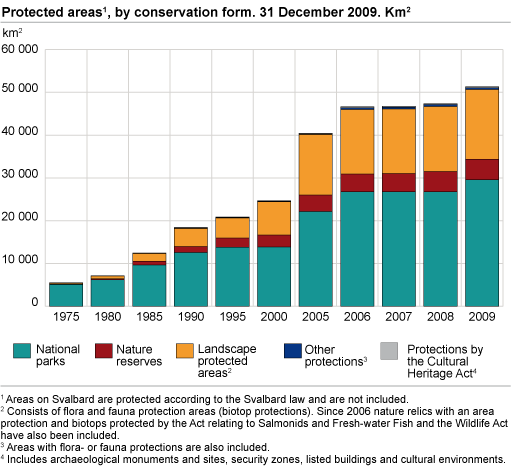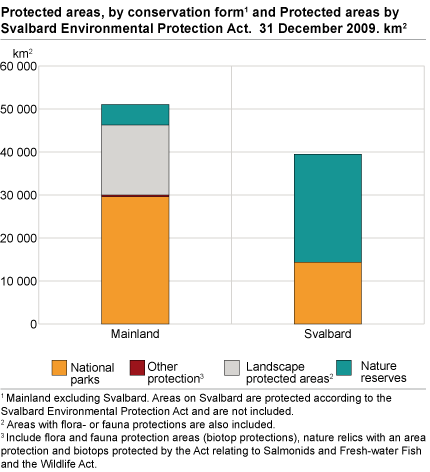Content
Published:
This is an archived release.
Three new national parks last year
Almost 16 per cent of the Norwegian mainland, and as much as 65 per cent of Svalbard, is conserved. There were a total of 121 new preserved areas in 2009. National parks account for over half of these areas on the mainland. On Svalbard, most of these areas are made up of nature reserves.
The Kingdom of Norway has a total of 39 national parks. Thirty-two of these are on the mainland and 7 on Svalbard. The area of national parks is more than 43 900 km2, which is distributed into approximately 29 600 km2 on the mainland and 14 400 km2 on Svalbard. While national parks are the dominant category within conservation on the Norwegian mainland, is it nature reserves that dominate on Svalbard. However, national parks on Svalbard make up 24 per cent of the total conservation area.
National parks vary in size
On the mainland, the largest national park Hardangervidda has an area of about 3 445 km2. The smallest national park is Ormtjernkampen, with less than 9 km2. The largest national park on Svalbard is South Spitsbergen, which is 4 957 km2, and the smallest, which is almost 70 times larger than the smallest on the mainland, is Indre Wijdefjorden, with 613 km2. Svalbard is mainly located on Spitsbergen and Prins Karls Forland. With regard to counties, Oppland and Nordland have the largest area of protected area of national parks, with approximately 5 000 km2 each. Not all counties have national parks.
Nature reserves on Svalbard are equivalent to the area of national parks on the mainland
The most frequently occurring category of conservation form is nature reserves. There are 21 of these on Svalbard and more than 1 900 in Norway. On the mainland, nature reserves do not cover a larger area, but on Svalbard it is this form of conservation that has the largest area (41 per cent). The group of islands has a total of 25 200 km2 of nature reserves; approximately the same size of area as the national parks on the mainland. The largest nature reserve on Svalbard is Bjørnøya, with 177 km2. The smallest nature reserve is the bird sanctuary Guissezholmen, which is less than 1 km2.
Nature reserves are located in all counties. Hedmark has the largest area of nature reserve, and also the highest percentage of protected areas of nature reserves of all the counties. Oslo has the smallest conservation area of nature reserves, while Hordaland is the county with the lowest percentage of area from conservation of nature reserves.
Svalbard has non-landscape protected areas
Landscaped protected areas, with 16 291 km2, make up an important part of the total area of conservations on the mainland (32 per cent). In 2009, there were 11 new landscape protected areas, with an area of about 1 100 km2. By area, they make up about half of the national parks. All the counties have landscaped protected areas. Both in terms of area and percentage of the total landscaped protected area it is Møre and Romsdal that has most, while Østfold has the smallest conservation area of landscaped protected areas. Svalbard has non-landscape protected areas.
In 2009 the category other protections has had a large rise from 406 to 474. Other protection make up less than 1 per cent of the Norwegian area. Svalbard has to compare only one conservation area of other protection - a protected geotop area that is located on the west cost of Spitsbergen.
| Number of protected areas | Area (including freshwater), km2 | Per cent of Norway1 | |||||||||||||||||||||||||||||||||||||||||||||||||||||||||||||||||||||||||||||
|---|---|---|---|---|---|---|---|---|---|---|---|---|---|---|---|---|---|---|---|---|---|---|---|---|---|---|---|---|---|---|---|---|---|---|---|---|---|---|---|---|---|---|---|---|---|---|---|---|---|---|---|---|---|---|---|---|---|---|---|---|---|---|---|---|---|---|---|---|---|---|---|---|---|---|---|---|---|---|---|
| Total | 2 612 | 51 074 | 15.8 | ||||||||||||||||||||||||||||||||||||||||||||||||||||||||||||||||||||||||||||
| National parks | 32 | 29 582 | 9.1 | ||||||||||||||||||||||||||||||||||||||||||||||||||||||||||||||||||||||||||||
| Landscape protected areas2 | 195 | 16 291 | 5.0 | ||||||||||||||||||||||||||||||||||||||||||||||||||||||||||||||||||||||||||||
| Nature reserves | 1 911 | 4 774 | 1.5 | ||||||||||||||||||||||||||||||||||||||||||||||||||||||||||||||||||||||||||||
| Other protections3 | 474 | 427 | 0.1 | ||||||||||||||||||||||||||||||||||||||||||||||||||||||||||||||||||||||||||||
| 1 |
Mainland excluding Svalbard. Areas on Svalbard are protected according to the Svalbard Environmental
Protection Act and are not included. |
| 2 | Areas with flora- or fauna protections are also included. |
| 3 |
Include flora and fauna protection areas (biotop protections), nature relics with an area protection and
biotops protected by the Act relating to Salmonids and Fresh-water Fish and the Wildlife Act. |
| Number of protected areas | Area (including freshwater), km2 | Per cent of Svalbard1 | |||||||||||||||||||||||||||||||||||||||||||||||||||||||||||||||||||||||||||||
|---|---|---|---|---|---|---|---|---|---|---|---|---|---|---|---|---|---|---|---|---|---|---|---|---|---|---|---|---|---|---|---|---|---|---|---|---|---|---|---|---|---|---|---|---|---|---|---|---|---|---|---|---|---|---|---|---|---|---|---|---|---|---|---|---|---|---|---|---|---|---|---|---|---|---|---|---|---|---|---|
| Total | 29 | 39 482 | 64.7 | ||||||||||||||||||||||||||||||||||||||||||||||||||||||||||||||||||||||||||||
| National parks | 7 | 14 359 | 23.5 | ||||||||||||||||||||||||||||||||||||||||||||||||||||||||||||||||||||||||||||
| Nature reserves | 21 | 25 109 | 41.1 | ||||||||||||||||||||||||||||||||||||||||||||||||||||||||||||||||||||||||||||
| Other protections2 | 1 | 14 | 0.0 | ||||||||||||||||||||||||||||||||||||||||||||||||||||||||||||||||||||||||||||
| 1 |
Areas on Svalbard are protected according to the Svalbard Environmental Protection Act and are
not included. |
| 2 |
Include flora and fauna protection areas (biotop protections), nature relics with an area protection
and biotops protected by the Act relating to Salmonids and Fresh-water Fish and the Wildlife Act. |
Cultural heritage has a small amount of area
The amount of conservation areas in total is more than 76 200 for the mainland and Svalbard together. In spite of the high amount, the cultural heritage only consists of 231 km2. It is the archaeological monuments and sites on the mainland that form this area.
Archaeological monuments and site dominate
Archaeological monuments and sites are the dominating category within the cultural heritage form both in number and area. This is also the situation on the mainland and Svalbard. Archaeological monuments and sites total 92 and 80 per cent respectively. On Svalbard, most of them are located along the coast at Spitsbergen and Prins Karls Forland. On the mainland, most archaeological monuments and sites are registered in Hedmark, while Rogaland and Oppland have the largest areas conserved for these purposes.
Listed buildings on Svalbard make up 20 per cent of the cultural heritage. Thirty-one per cent of the cultural environments on the mainland are found in Buskerud. Not all counties have cultural environments, and Svalbard has none.
Most security zones are in Finnmark
Finnmark has most security zones, both in area and number, with about 19 and 8 per cent of the total. All counties have security zones. Svalbard does not have security zones.
| Number of protected areas | Area (including freshwater), km2 | Per cent of Norway | |||||||||||||||||||||||||||||||||||||||||||||||||||||||||||||||||||||||||||||
|---|---|---|---|---|---|---|---|---|---|---|---|---|---|---|---|---|---|---|---|---|---|---|---|---|---|---|---|---|---|---|---|---|---|---|---|---|---|---|---|---|---|---|---|---|---|---|---|---|---|---|---|---|---|---|---|---|---|---|---|---|---|---|---|---|---|---|---|---|---|---|---|---|---|---|---|---|---|---|---|
| Total | 75 045 | 230.9 | 0.1 | ||||||||||||||||||||||||||||||||||||||||||||||||||||||||||||||||||||||||||||
| Listed buildings | 5 674 | 0.9 | 0.0 | ||||||||||||||||||||||||||||||||||||||||||||||||||||||||||||||||||||||||||||
| Cultural environments | 11 | 58.1 | 0.0 | ||||||||||||||||||||||||||||||||||||||||||||||||||||||||||||||||||||||||||||
| Archaeological monuments and sites | 69 053 | 150.8 | 0.0 | ||||||||||||||||||||||||||||||||||||||||||||||||||||||||||||||||||||||||||||
| Security sones | 307 | 21.1 | 0.0 | ||||||||||||||||||||||||||||||||||||||||||||||||||||||||||||||||||||||||||||
| Number of protected areas | Area (including freshwater), km2 | Per cent of Svalbard | |||||||||||||||||||||||||||||||||||||||||||||||||||||||||||||||||||||||||||||
|---|---|---|---|---|---|---|---|---|---|---|---|---|---|---|---|---|---|---|---|---|---|---|---|---|---|---|---|---|---|---|---|---|---|---|---|---|---|---|---|---|---|---|---|---|---|---|---|---|---|---|---|---|---|---|---|---|---|---|---|---|---|---|---|---|---|---|---|---|---|---|---|---|---|---|---|---|---|---|---|
| Total | 1 195 | 0.2 | 0.0 | ||||||||||||||||||||||||||||||||||||||||||||||||||||||||||||||||||||||||||||
| Listed buildings | 241 | 0.0 | 0.0 | ||||||||||||||||||||||||||||||||||||||||||||||||||||||||||||||||||||||||||||
| Archaeological monuments and sites | 954 | 0.2 | 0.0 | ||||||||||||||||||||||||||||||||||||||||||||||||||||||||||||||||||||||||||||
Pressure on the nature and the cultural heritage
The population growth and modernisation of society have increased the pressure on natural and cultural heritage in recent decades. The Nature Conservation Act and the Cultural Heritage Act are important tools for the authorities in safeguarding a diversity of nature and culture for the future.
See also:State of the Environment in Norway: http://www.environment.no/ The Nature Conservation Act and the Cultural Heritage Act: http://www.lovdata.no/ The Norwegian Mapping and Cadastre Authority: http://www.statkart.no/ The Directorate for Nature Management: http://english.dirnat.no/ The Directorate for Cultural Heritage: http://www.riksantikvaren.no/English/ The International Union for the Conservation of Nature and Natural Resources: http://www.iucn.org/ Area - theme page: http://www.ssb.no/english/subjects/01/01/areal_en/ The International Union for the Conservation of Nature and Natural Resources: http://www.iucn.org/ |
|
Figures for all years in StatBank tables 04604 and 03935 were corrected 13 May 2011. Each single year were before this displaced one year ahead. The 1998 column contained figures for 1997, the column for 1998 contained figures for 1997 and so on. The diplacement concerned all years as far as 2009, that until 13 May were stated to be 2010-figures. Figures for 2010 will be published later. |
Tables:
Contact
-
Svein Johan Reid
E-mail: sjr@ssb.no
tel.: (+47) 41 51 29 66
-
Jørn Kristian Undelstvedt
E-mail: jorn.kristian.undelstvedt@ssb.no
tel.: (+47) 94 50 68 64


